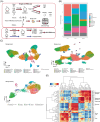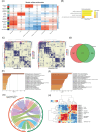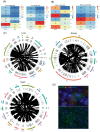Dissecting the immune discrepancies in mouse liver allograft tolerance and heart/kidney allograft rejection
- PMID: 37748771
- PMCID: PMC10905343
- DOI: 10.1111/cpr.13555
Dissecting the immune discrepancies in mouse liver allograft tolerance and heart/kidney allograft rejection
Abstract
The liver is the most tolerogenic of transplanted organs. However, the mechanisms underlying liver transplant tolerance are not well understood. The comparison between liver transplantation tolerance and heart/kidney transplantation rejection will deepen our understanding of tolerance and rejection in solid organs. Here, we built a mouse model of liver, heart and kidney allograft and performed single-cell RNA sequencing of 66,393 cells to describe the cell composition and immune cell interactions at the early stage of tolerance or rejection. We also performed bulk RNA-seq of mouse liver allografts from Day 7 to Day 60 post-transplantation to map the dynamic transcriptional variation in spontaneous tolerance. The transcriptome of lymphocytes and myeloid cells were characterized and compared in three types of organ allografts. Cell-cell interaction networks reveal the coordinated function of Kupffer cells, macrophages and their associated metabolic processes, including insulin receptor signalling and oxidative phosphorylation in tolerance induction. Cd11b+ dendritic cells (DCs) in liver allografts were found to inhibit cytotoxic T cells by secreting anti-inflammatory cytokines such as Il10. In summary, we profiled single-cell transcriptome analysis of mouse solid organ allografts. We characterized the immune microenvironment of mouse organ allografts in the acute rejection state (heart, kidney) and tolerance state (liver).
© 2023 The Authors. Cell Proliferation published by Beijing Institute for Stem Cell and Regenerative Medicine and John Wiley & Sons Ltd.
Conflict of interest statement
The authors declare no competing interests.
Figures





Similar articles
-
Spontaneous acceptance of mouse kidney allografts is associated with increased Foxp3 expression and differences in the B and T cell compartments.Transpl Immunol. 2011 Apr 15;24(3):149-56. doi: 10.1016/j.trim.2010.12.004. Epub 2011 Jan 1. Transpl Immunol. 2011. PMID: 21199671
-
Infiltrating Foxp3(+) regulatory T cells from spontaneously tolerant kidney allografts demonstrate donor-specific tolerance.Am J Transplant. 2013 Nov;13(11):2819-30. doi: 10.1111/ajt.12445. Epub 2013 Sep 18. Am J Transplant. 2013. PMID: 24102948
-
Kidney-induced systemic tolerance of heart allografts in mice.JCI Insight. 2020 Sep 17;5(18):e139331. doi: 10.1172/jci.insight.139331. JCI Insight. 2020. PMID: 32938831 Free PMC article.
-
Immunologic basis of graft rejection and tolerance following transplantation of liver or other solid organs.Gastroenterology. 2011 Jan;140(1):51-64. doi: 10.1053/j.gastro.2010.10.059. Epub 2010 Nov 9. Gastroenterology. 2011. PMID: 21073873 Free PMC article. Review.
-
Mechanisms of murine spontaneous liver transplant tolerance.Exp Clin Transplant. 2014 Feb;12(1):1-8. doi: 10.6002/ect.2013.0154. Exp Clin Transplant. 2014. PMID: 24471716 Review.
Cited by
-
Liver transplantation and immune tolerance: Setting the stage for optimal post-transplant status.ILIVER. 2024 May 20;3(2):100097. doi: 10.1016/j.iliver.2024.100097. eCollection 2024 Jun. ILIVER. 2024. PMID: 40636478 Free PMC article. No abstract available.
-
The immune duality of osteopontin and its therapeutic implications for kidney transplantation.Front Immunol. 2025 Feb 28;16:1520777. doi: 10.3389/fimmu.2025.1520777. eCollection 2025. Front Immunol. 2025. PMID: 40093009 Free PMC article. Review.
-
Optimizing the mouse orthotopic liver transplantation model: Learning curve, technical enhancements, and keys to success.Liver Transpl. 2025 Sep 1;31(9):1123-1134. doi: 10.1097/LVT.0000000000000612. Epub 2025 Mar 26. Liver Transpl. 2025. PMID: 40130965 Free PMC article.
-
Regulatory dendritic cell therapy in organ transplantation.Curr Opin Organ Transplant. 2024 Apr 1;29(2):121-130. doi: 10.1097/MOT.0000000000001127. Epub 2023 Nov 22. Curr Opin Organ Transplant. 2024. PMID: 37991065 Free PMC article. Review.
References
-
- Loupy A, Lefaucheur C. Antibody‐mediated rejection of solid‐organ allografts. New Engl J Med. 2018;379(12):1150‐1160. - PubMed
-
- Thomson AW, Vionnet J, Sanchez‐Fueyo A. Understanding, predicting and achieving liver transplant tolerance: from bench to bedside. Nat Rev Gastroentrol Hepatol. 2020;17(12):719‐739. - PubMed
MeSH terms
Grants and funding
LinkOut - more resources
Full Text Sources
Medical
Research Materials

